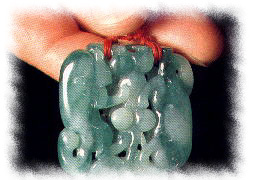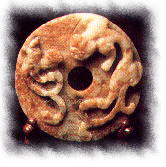Design Arts -- Jade
In Chinese, "jade"(yu) refers to a fine, beautiful stone with a warm color and rich luster, that is skillfully carved. In Chinese culture, jade symbolizes nobility, perfection, constancy, and immortality. For ages, jade has been an intimate part of the lives of all Chinese. It is considered the most valuable of all precious stones. Jade is found in mountains and riverbeds, and Chinese consider jade to be "the essence of heaven and earth."
Jade is an essence produced through the natural forces of rivers and mountains over eons. However, if it is not skillfully cut and polished, there is no way for the potential richness and luster that people prize to be expressed. The Chinese have a saying that goes. "If jade is not properly cut, it cannot be made into a useful utensil." Cutting is an important step in the process of producing jade articles.
Tradition
The earliest jade object found in China was a piece of a serpentine jade unearthed in the Immortal Cave in Haicheng of Liaoning Province and dating back to the New Stone Age, more than 12,000 years ago. The second piece was a small hanging jade article excavated at the site of Hemudu in Zhejiang Province and dating back more than 7,000 years. Jadeware in that period was mainly used for personal decoration. A large number of exquisite jade objects were produced 4,000 years ago. Jade objects at that time was mainly used for witchcraft and as an emblem of privileges.

|
When polished and carved into various objects, jade was attributed with certain cultural characteristics. In ancient Chinese cosmology, the heaven was considered to be round, and the earth square. Thus a round jade ornament with a hole in the center, called a "pi", was carved to honor the gods of heaven, and a long hollow jade ornament with rectangular sides, called a "ts'ung", was made to honor the terrestrial spirits. According to ancient Chinese legend, the phoenix and the dragon were animal deities that were the life-source of family clans. For this reason, jade was often used as a material for carving phoenixes and dragons which worn as ornaments. These ornaments symbolized the noble bearings of a gentleman, and are the origin of the Chinese saying : "The gentleman's morals are like jade."
Sacrificial and auspicious articles were used in ancient rites and are generally referred to as "ritual utensils." Sacrificial utensils were used in offerings to ancestors or in paying ceremonial respect to the gods of heaven and earth. Archaeological findings show that people of the Neolithic Era carved a great number of "pi" and "ts'ung" for use as sacrificial utensils. The concept of a round heaven and rectangular earth, which eventually became deeply ingrained in the Chinese mind, may have first emerged around this time. "Auspicious utensils" were carried or worn by the nobility as symbols of their office or authority. For example, jade axes and spades later evolved into "kuei", elongated pointed tablets of jade. When the "son of heaven," or emperor, dispatched an official for external duty, he would give him a "tablet of authority" made from jade to proclaim the task assigned to him by the "son of heaven." The traditional function of ritual jade utensils gradually began to fade after the Han Dynasty (206 B.C. to 220 A.D.), when only a small number of sacrificial jade utensils were used in ceremonial rites led by the emperor.
"The living wear jade as a symbol of their moral integrity, and jade accompanies the deceased to comfort their souls."
Over four thousand years ago in China, great quantities of jade utensils were often laid over or around a casket, particularly the "pi" and "ts'ung". They were a symbolic link of communication between heaven and earth, of exchange between man and the spiritual world. Later, jade articles were carved specifically for burial with the dead, based on the idea that the jade's qualities of nobility, perfection, constancy, and immortality would prevent the physical body from decay. The ancient Chinese used jade burial objects such as a thin, light jade cicada which was placed in the mouth of the dead and a thick, round jade piglet which was enclosed in a hand of the deceased. The belief was that a cicada went underground and was "reborn" after shedding its skin and that a pig bred quickly, thus increasing wealth. Thus natural motifs were used to express human desires for reincarnation and increased wealth for one's family.

|
Modern Day
Jade ornaments have remained popular up until the present day. The purchase, wearing, and giving of jade items as gifts is still very common. Jade is viewed as an ideal gift for couples making a mutual commitment, and for one's children when they get married. Even now, the Chinese retain the idea that in addition to being beautiful, jade can protect from misfortune and bring good luck.
Today, traditional forms and modern styles are combined into striking new creations, and modern technology has greatly elevated the quality of workmanship. No longer is jade for the exclusive use of emperors and noblemen; just about everyone has the means to own and wear jade. Beyond maintaining its historical role, jade artistry has been further developed with creativity and skill, and has become an indispensable part of everyday life. Jade remains an eternal symbol of China's magnificent civilization.



 Chinese Culture
Chinese Culture